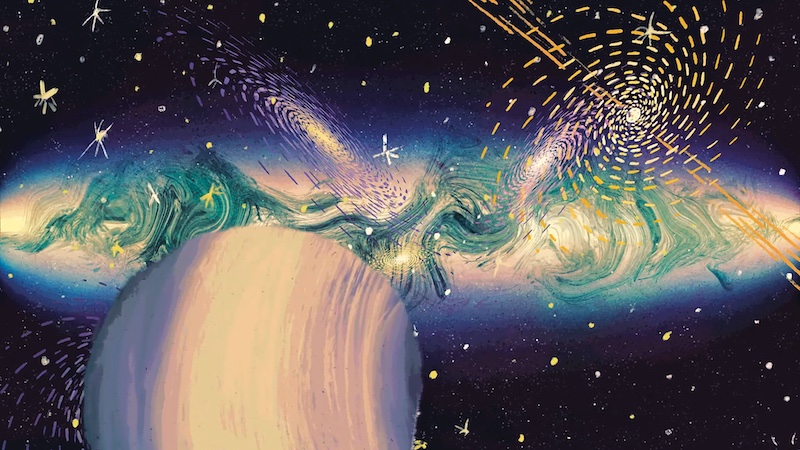
11th and 12th highlight of the #GaiaDR3 data products, covering Gaia's extragalactic content. Today, #GaiaDPAC Extended Objects team is meeting at @CNES to discuss future Gaia releases. Learn in this thread about the published galaxies & quasars in #GaiaDR3 👇🏼 

The story on #GaiaDR3 galaxies can be found here: cosmos.esa.int/web/gaia/dr3-g…, the story on the published quasars is available here: cosmos.esa.int/web/gaia/dr3-q…. These stories are part of a set of 20 stories describing the many #GaiaDR3 data products. 

~ 1 million active galactic nuclei are found through the variability chain of #GaiaDPAC, but also 2.5 million galaxy candidates, even though they are not variable. To Gaia they seem variable due to their extension combined with Gaia's on-board detection algorithm & scanning law. 

#GaiaDR3 contains a sample of 4.8 million galaxy candidates. This catalogue is aimed at being complete rather than pure, as described in the paper by Gaia Collaboration, Bailer-Jones, et al. 2022. 

A more pure subset of these galaxy candidates is available, containing 2.9 million galaxies. This subset has an estimated purity of 94%. Some evidence of impurity can still be seen near the Magellanic Clouds, where some overdensities are visible. 

#GaiaDPAC's Extended Object team retrieved the 2D surface brightness profile for the extragalactic sources by combining the information of the various 1D observations by Gaia. The parameters of the specific light profile that best matches the observations are then computed. 

Below we see a comparison of a synthetic image by Gaia (as created from the fitted parameters of the light profile) with an actual image taken from the ground by PanSTARRS (left). From the ground, the atmosphere blurs the image, while Gaia (right) "sees" more precisely its shape. 

Of the 914,837 surface brightness profiles for galaxies available in #GaiaDR3, 57% were not measured from the ground. With Gaia we explore a population of tiny galaxies never resolved from the ground. More details in the paper by Ducourant, et al. 2022. 

With the redshift measurements for these galaxies provided in #GaiaDR3, we can estimate the time taken by the photon to reach us (from the galaxy to Gaia). 

The below figure shows the synthetic reconstructed images of galaxies from Gaia with an indication of their lookback time: from the closest galaxy in #GaiaDR3 (at 0.2 Gigayears) to the farthest one (at 5.4 Gigayears) 

It is the first time for Gaia that results from the extended objects pipeline were published! More is coming in future data releases! Full details on the galaxies in #GaiaDR3 from this story cosmos.esa.int/web/gaia/dr3-g… and from the papers: cosmos.esa.int/web/gaia/dr3-p… 

But Gaia's extragalactic content does not just contain galaxies, #GaiaDR3 contains lots of quasars as well: cosmos.esa.int/web/gaia/dr3-q… Quasars are so distant that their physical movement relative to the Solar System is incredibly small. 

Gaia still observes some apparent proper motion in the quasars, which is a combination of observational noise & tiny effects reflecting the motion of the Solar System in the Universe, one of the top stories published for #GaiaEDR3: cosmos.esa.int/web/gaia/edr3-…
Because quasar positions are fixed in the observations taken by Gaia, quasars can be used as reference points. A selection of known quasars was used as the set of reference points to form an optical reference frame: the Gaia Celestial Reference Frame 3: aanda.org/component/arti… 

With #GaiaDR3 a catalogue of 6.6 million quasar candidates was published. This data set is aimed at being complete rather than pure. It is a result from various modules in #GaiaDPAC that exploit the different Gaia data products and are aimed at finding quasars. 

A purer subsample of quasars is available containing about 1.9 million sources with an estimated overall purity of 95%. The galactic plane has a much lower density for this purer subset (similar to what is seen in the sky map of the purer subset of galaxies). 

The query to obtain this pure sample of quasars is available from the paper "#GaiaDR3: the extragalactic content” by the Gaia Collaboration, Bailer-Jones, et al. 2022". A list of queries by the #GaiaDPAC is available from the Gaia help pages: cosmos.esa.int/web/gaia-users… 

From Gaia's low-resolution BP/RP spectra redshifts were computed for 1.7 million quasars. Knowing the redshift of a quasar tells us its age & thus its place in the evolution of the Universe. Knowing the age of a sequence of quasars helps to understand how quasars evolve with time 

Quasar redshifts also allow us to construct a composite quasar spectrum that itself may serve as a reference spectrum to classify individual quasars. The animation below shows how this is done. Full details 👉🏾 cosmos.esa.int/web/gaia/dr3-q…
Quasars are active galactic nuclei that are extremely energetic and bright and are very distant from us. They result from the interaction of a central supermassive black hole with the surrounding galactic matter. 

Usually, the host galaxies of quasars are too distant to be measured and studied but, thanks to the exceptional resolving power of Gaia, it has been possible to detect 64,498 host galaxies and determine the surface brightness profiles for 15,867 of them. 

#GaiaDR3 brings for the 1st time an all-sky survey of morphology of galaxies hosting a quasar. Details? “The extragalactic content” by Gaia Collaboration, et al. & "Surface brightness profiles of galaxies and host galaxies of quasars" by Ducourant, et al. cosmos.esa.int/web/gaia/dr3-q… 

• • •
Missing some Tweet in this thread? You can try to
force a refresh




